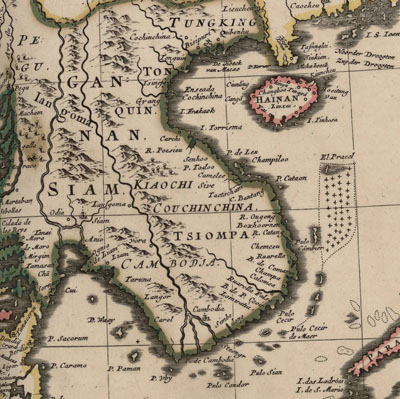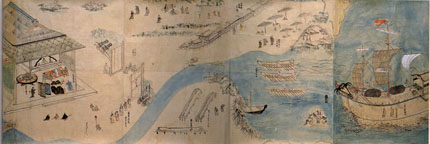
Map of Vietnam, dated to 1688 (Witt, © Biblioteca Nacional de Espana, GMG709152mapa0074). View larger version here.
Central Vietnam Between the 16th and 19th Century
Central Vietnam between the 16th and 19th century was a contested place, where two worlds overlapped: that of the Cham and that of the Nguyen Lords. The time span encompassed in this research can be seen as a long period of transition that witnesses change and transformation from the displacement of the Champa polities to the rise of Dang Trong (a.k.a. Cochinchina), culminating in the formation of Vietnam as we know it today in 1802 with the coronation of Gia Long: the first emperor of Vietnam.
From the 15th century, a new culture developed in central Vietnam; one that broke away from the Confucian / Chinese tradition of the Dai Viet in the north and imposed changes on the local Cham culture. It became the time of the Nguyen Lords. This major transformation in central Vietnam occured concurrently with the arrival of the Europeans. The first Europeans to land and to engage in trade were the crew of a Portuguese merchant ship, who accidentally landed on the coast of Champa after encountering a storm on their way to China in 1516. A few decades later Spanish merchants followed, and later still the Dutch, British and French also followed. This period was simultaneously a time of major migration in central Vietnam for the Viêt but also for the Cham, who maintained strong connections with the Malay world, resulting in widespread conversion to Islam among the Cham.
As Cochinchina developed and as the Viet people occupied the Cham lands, they adapted, adopted and transformed the region. From the 9th to the 15th century, Champa had been central in orchestrating the maritime trade networks, not only due to the many strategically located entrepôts under their control but also because of the products it could offer for export. The Cham knew how to benefit from the environment of the central coast. As they settled, the Nguyen also came to rely intensively on international maritime trade and learned to benefit from this ecology. As noted in recent scholarship, this suggests strong Cham precedents in the development of Dang Trong which implies that a focus on the ecology and on the maritime elements of life in the region of central Vietnam is thus warranted. In conclusion, by addressing this period of transition and change in central Vietnam through a focus on maritime events and boat technology will shed light on aspects the life along the central Vietnamese coast of which otherwise are often overlooked.

17th century view of the harbour of Faifoo (the Chaya Scroll, Property of Jyomyo-Ji Temple, Nagoya, Japan © Wikimedia Commons) View larger version here.
Previous Next
